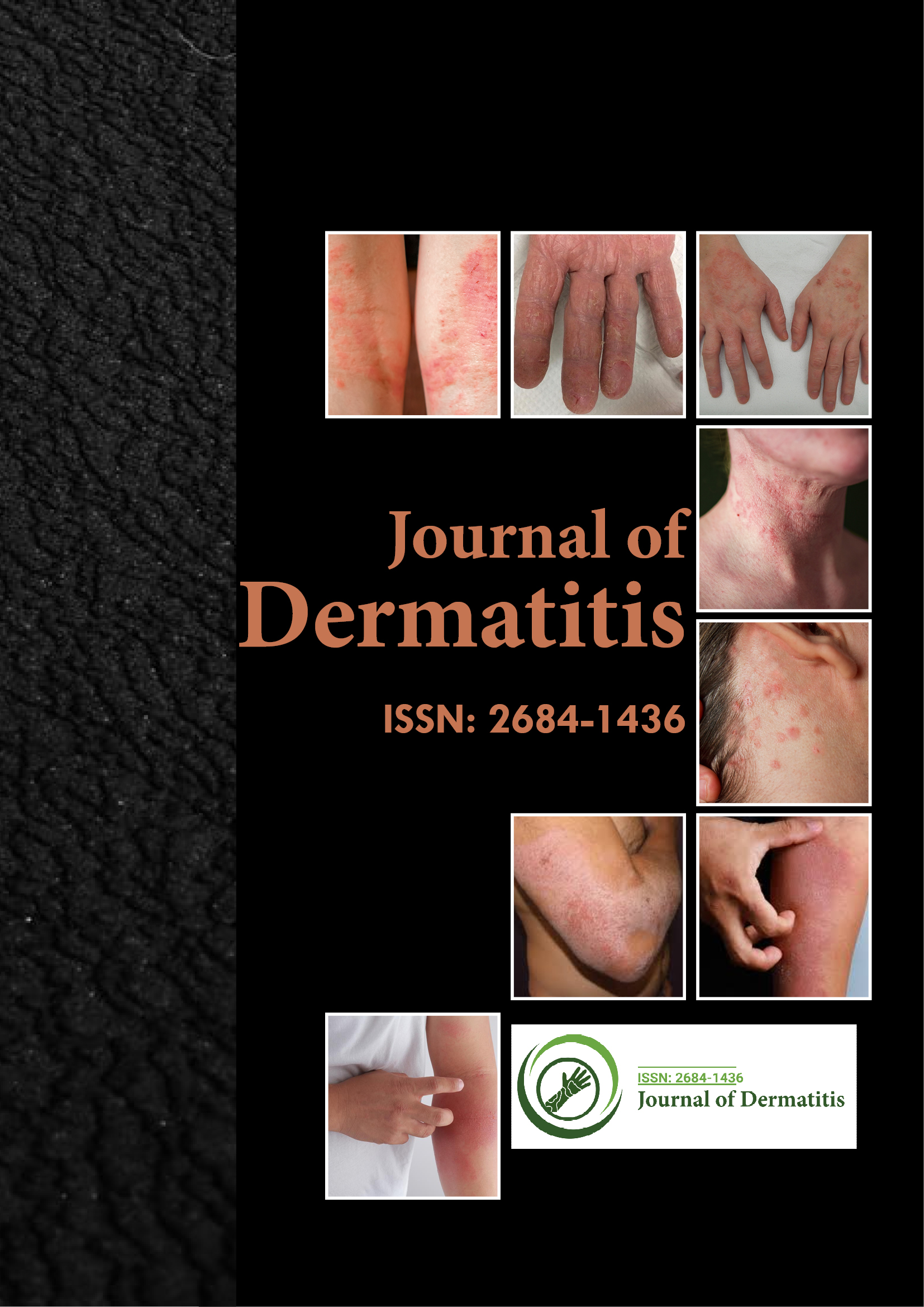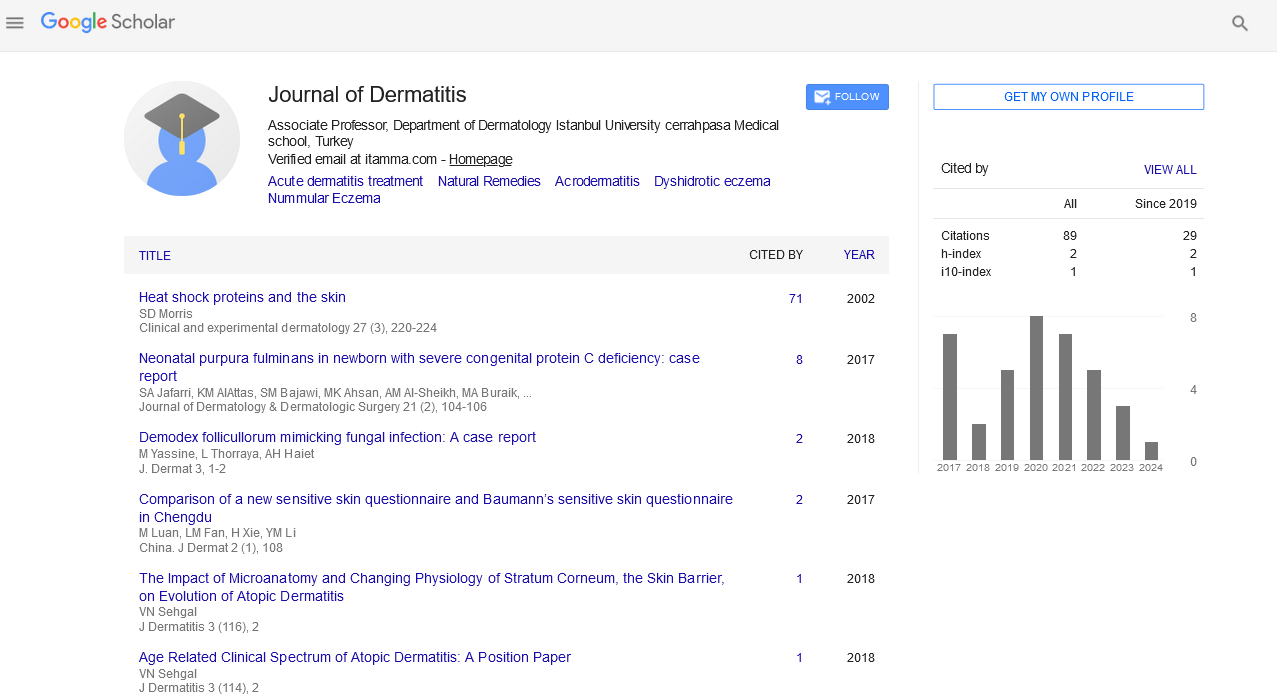Indexed In
- RefSeek
- Hamdard University
- EBSCO A-Z
- Euro Pub
- Google Scholar
Useful Links
Share This Page
Journal Flyer

Open Access Journals
- Agri and Aquaculture
- Biochemistry
- Bioinformatics & Systems Biology
- Business & Management
- Chemistry
- Clinical Sciences
- Engineering
- Food & Nutrition
- General Science
- Genetics & Molecular Biology
- Immunology & Microbiology
- Medical Sciences
- Neuroscience & Psychology
- Nursing & Health Care
- Pharmaceutical Sciences
Commentary - (2025) Volume 10, Issue 1
Genetic Markers for Susceptibility to Dermatitis
Penelope Kim*Received: 19-Jan-2024, Manuscript No. JOD-24-24653; Editor assigned: 23-Jan-2024, Pre QC No. JOD-24-24653 (PQ); Reviewed: 06-Feb-2024, QC No. JOD-24-24653; Revised: 06-Jan-2025, Manuscript No. JOD-24-24653 (R); Published: 13-Jan-2025, DOI: 10.35248/2684-1436.25.10.264
Abstract
Description
Genetic markers play a pivotal role in revealing the intricate genetic basis of dermatitis susceptibility. Dermatitis, a broad term encompassing various inflammatory skin conditions, manifests in diverse forms, with atopic dermatitis, contact dermatitis, and seborrheic dermatitis being among the most prevalent. The influence of genetics in dermatitis susceptibility has been a subject of extensive research, as understanding the underlying genetic markers holds significant potential for early detection, personalized treatment approaches, and a deeper comprehension of disease pathogenesis.
Atopic dermatitis, characterized by chronic inflammation and intense itching, is a multifactorial condition influenced by both genetic and environmental factors. Numerous studies have consistently demonstrated a hereditary component in atopic dermatitis, suggesting that individuals with a family history of the condition are at an increased risk. Identifying specific genetic markers associated with atopic dermatitis susceptibility has been a challenging yet important pursuit in dermatologic research.
Genome-Wide Association Studies (GWAS) have been instrumental in identifying genetic markers linked to atopic dermatitis. These large-scale studies analyze the entire genome to pinpoint variations that may contribute to disease susceptibility. Notably, several genes associated with skin barrier function, immune regulation, and inflammatory responses have been implicated in atopic dermatitis pathogenesis.
Filaggrin, a protein important for maintaining the integrity of the skin barrier, is one of the most well-studied genetic markers in atopic dermatitis. Loss-of-function mutations in the Filaggrin Gene (FLG) have been identified as a significant risk factor for atopic dermatitis. Individuals carrying these mutations exhibit compromised skin barrier function, leading to increased permeability and susceptibility to environmental triggers.
Apart from filaggrin, other genes involved in skin barrier maintenance, such as SPINK5 and FLG2, have also been associated with atopic dermatitis susceptibility. These genetic variations collectively contribute to the impaired barrier function observed in individuals with atopic dermatitis, rendering their skin more susceptible to allergens, irritants, and microbial colonization.
Moreover, variations in genes related to the metabolism of xenobiotics, such as cytochrome P450 enzymes, can impact an individual's ability to metabolize and detoxify certain environmental substances. Genetic markers in these metabolic pathways may influence susceptibility to contact dermatitis triggered by exposure to chemicals and irritants in the environment.
Seborrheic dermatitis, characterized by red, scaly patches and inflammation in areas rich in sebaceous glands, also exhibits genetic predispositions. Although the exact genetic markers for seborrheic dermatitis are not as extensively studied as in atopic and contact dermatitis, familial clustering and twin studies suggest a hereditary component.
Genetic factors related to the regulation of sebum production, immune responses to Malassezia, a yeast commonly found on the skin and implicated in seborrheic dermatitis, and variations in skin barrier-related genes may contribute to susceptibility. Identifying specific genetic markers associated with seborrheic dermatitis is an area of ongoing research that holds the potential to reveal novel therapeutic targets.
Understanding the genetic basis of dermatitis susceptibility goes beyond identifying individual genes; it involves deciphering the complex interactions between multiple genetic and environmental factors. The concept of polygenic inheritance, where multiple genes contribute to the overall genetic risk, adds a layer of complexity to the genetic landscape of dermatitis.
Gene-gene interactions, also known as epistasis, further influence the manifestation of dermatitis. The combined effects of variations in multiple genes may amplify or mitigate the risk of dermatitis, making it challenging to pinpoint a single causative factor. Moreover, gene-environment interactions play a important role, as environmental exposures can modulate the expression of certain genes, influencing disease susceptibility.
As advancements in genomics and bioinformatics continue, researchers are employing sophisticated techniques to unravel the intricacies of the genetic architecture of dermatitis. The integration of large-scale genetic data, including whole-genome sequencing and functional genomics, facilitates a more comprehensive understanding of the genetic factors contributing to dermatitis susceptibility.
One promising avenue in dermatitis research is the exploration of non-coding regions of the genome, often dismissed as "junk DNA" in the past. These non-coding regions, including long non-coding RNAs and enhancer elements, play important roles in gene regulation and may harbor key genetic markers influencing dermatitis susceptibility.
The clinical implications of identifying genetic markers for dermatitis susceptibility are vast. Early detection of genetic predispositions could enable personalized risk assessments, allowing for targeted preventive strategies and interventions. Individuals identified as genetically predisposed to dermatitis could be counseled on lifestyle modifications, skincare practices, and environmental adjustments to minimize triggers and reduce the risk of disease development.
Genetic markers may also guide the development of novel therapeutic approaches. Precision medicine, tailored to an individual's genetic profile, holds promise for more effective and targeted dermatitis treatments. For example, individuals with specific genetic variants associated with impaired skin barrier function might benefit from interventions aimed at reinforcing the skin barrier.
Conclusion
The impact of genetic markers on dermatitis susceptibility is a dynamic and evolving field of research. From atopic dermatitis to contact dermatitis and seborrheic dermatitis, the intricate interplay between genetic and environmental factors contributes to the complexity of dermatologic conditions. The genetic basis of dermatitis holds the key to personalized medicine, allowing for targeted interventions and improved outcomes for individuals affected by these challenging skin conditions. As research advances, the integration of genetic insights into clinical.Citation: Kim P (2025) Genetic Markers for Susceptibility to Dermatitis. J Dermatitis. 10:264.
Copyright: © 2025 Kim P. This is an open access article distributed under the terms of the Creative Commons Attribution License, which permits unrestricted use, distribution, and reproduction in any medium, provided the original author and source are credited.

